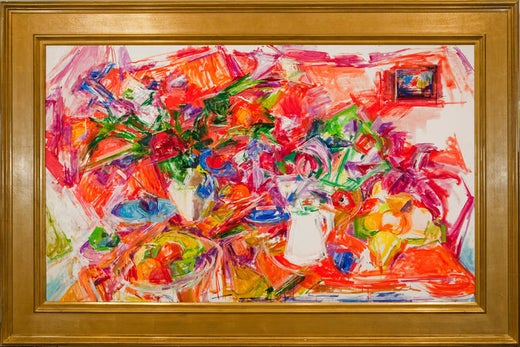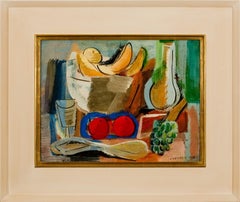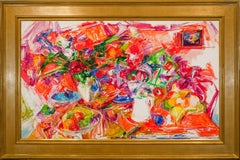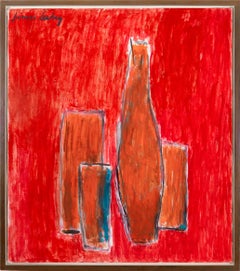Mercedes Matter"Table Top Flowers"
About the Item
- Creator:Mercedes Matter (1913-2001, American)
- Dimensions:Height: 40 in (101.6 cm)Width: 34 in (86.36 cm)Depth: 2 in (5.08 cm)
- Medium:
- Movement & Style:
- Period:
- Condition:
- Gallery Location:Lambertville, NJ
- Reference Number:Seller: NJOL1661stDibs: LU374271232
Mercedes Matter
Born in New York in 1913 to famed Philadelphia modernist Arthur B. Carles, Mercedes Matter grew up surrounded by art.
Throughout her youth Matter traveled to France and Italy with her family, where she was especially struck by the works of Giovanni Bellini. She later went on to study sculpture with Lu Duble at Bennett Junior College in Millbrook, New York, and with Maurice Sterne and Alexander Archipenko in New York City during her breaks from school. After finishing at Bennett Junior College, Matter began classes at the New York Art Students League with Hans Hofmann, who became a great mentor and friend to Matter. Hofmann’s painting classes brought the influence of the European avant-garde movements to Matter’s work.
In the late 1930s, Matter became a founding member of the American Abstract Artists group and worked for the Works Progress Administration with French artist Fernand Léger. Léger would later introduce Matter to her husband, Swiss photographer and designer Herbert Matter. The Matters became significant figures in the mid-20th century New York art scene, along with Jackson Pollock, Lee Krasner, Alexander Calder, and both Willem and Elaine de Kooning.
Matter was a member of the teaching faculty at the Philadelphia College of Art (now University of the Arts), Pratt Institute, and New York University. In 1964, she founded her own school, the New York Studio School of Drawings, Paintings, and Sculpture, after she noticed a lack of studio classes available to students. Matter considered the studio a quintessential form of study in art education. The school is still in operation today.
Matter has had solo exhibitions at Tanager Gallery, NY; Yale Norfolk, CT; Washington Art Association, CT; East Hampton Center for Contemporary Art, NY; the New York Studio School; and Salander-O’Reilly Galleries, NY. Her work can be found in the collections at the Corcoran Gallery, Washington, D.C.; Delaware Art Museum; Parrish Museum, NY; and the Whitney Museum of American Art, NY. She has received the Distinguished Teaching Award from the College Art Association; the Gottlieb Foundation Grant; the Ingram Merrill Foundation Grant; and the Tiffany & Co. Foundation Grant.
Find original Mercedes Matter paintings and other art on 1stDibs.
(Biography provided by Jim’s of Lambertville)
You May Also Like
Late 20th Century Abstract Expressionist Abstract Paintings
Canvas, Oil
Late 20th Century Abstract Expressionist Abstract Paintings
Canvas, Oil
Late 20th Century Abstract Expressionist Abstract Paintings
Canvas, Oil
Late 20th Century Abstract Expressionist Abstract Paintings
Canvas, Oil
Late 20th Century Abstract Expressionist Abstract Paintings
Canvas, Oil
20th Century Abstract Expressionist Still-life Paintings
Canvas, Oil
Early 2000s Abstract Expressionist Abstract Paintings
Oil, Cardboard, Canvas
1980s Abstract Expressionist Still-life Paintings
Oil, Canvas
1950s Abstract Expressionist Still-life Paintings
Oil, Canvas
1990s Abstract Expressionist Still-life Paintings
Canvas, Oil
More From This Seller
View All1930s Abstract Expressionist Abstract Paintings
Oil, Board
20th Century Abstract Abstract Paintings
Canvas, Oil
20th Century Abstract Abstract Paintings
Canvas, Oil
1990s Abstract Abstract Paintings
Canvas, Oil
1950s Abstract Expressionist Abstract Paintings
Canvas, Oil
1930s Abstract Expressionist Abstract Paintings
Canvas, Oil




